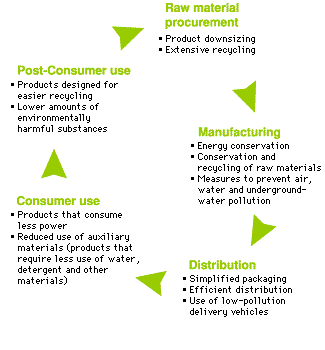| Life cycle assessment determines the environmental impacts of products, processes or services, through production, usage, and disposal. |
- Life Cycle Assessment:
A systematic set of procedures for compiling and examining the inputs and outputs of materials and energy and the associated environmental impacts directly attributable to the functioning of a product or service system throughout its life cycle.
- Life Cycle:
Consecutive and interlinked stages of a product or service system, from the extraction of natural resources to the final disposal.
- ISO 14040.2 Draft: Life Cycle Assessment - Principles and Guidelines
What is LCA?
Life Cycle Assessment (LCA) is a technique for assessing the potential environmental aspects and potential aspects associated with a product (or service), by:
- compiling an inventory of relevant inputs and outputs,
- evaluating the potential environmental impacts associated with those inputs and outputs,
- interpreting the results of the inventory and impact phases in relation to the objectives of the study.
- ISO 14040.2 Draft: Life Cycle Assessment - Principles and Guidelines
Life-cycle assessments (LCAs) involve cradle-to-grave analyses of production systems and provide comprehensive evaluations of all upstream and downstream
energy inputs and multimedia environmental emissions. LCAs can be costly and time-consuming, thus limiting their use as analysis techniques in both the public and private sectors. Streamlined techniques for conducting LCAs are needed to lower the cost and time involved with LCA and to encourage a broader audience to begin using LCA.
- Research Triangle Institute (RTI)
Life-cycle assessment has emerged as a valuable decision-support
tool for both policy makers and industry in assessing the cradle-to-grave
impacts of a product or process. Three forces are driving this evolution.
First, government regulations are moving in the direction of "life-cycle
accountability;" the notion that a manufacturer is responsible not
only for direct production impacts, but also for impacts associated with
product inputs, use, transport, and disposal. Second, business is participating
in voluntary initiatives which contain LCA and product stewardship components.
These include, for example, ISO 14000 and the Chemical Manufacturer Association's Responsible Care Program, both of which seek to foster continuous improvement through better environmental management systems. Third, environmental "preferability" has emerged as a criterion in both consumer markets and government procurement guidelines. Together these developments have placed LCA in a central role as a tool for identifying cradle-to-grave impacts both of products and the materials from which they are made.
The "life-cycle" or "cradle-to-grave" impacts include
the extraction of raw materials; the processing, manufacturing, and fabrication
of the product; the transportation or distribution of the product to the
consumer; the use of the product by the consumer; and the disposal or recovery
of the product after its useful life.
There are four linked components of LCA:
- Goal definition and scoping: identifying the LCA's purpose and
the expected products of the study, and determining the boundaries (what
is and is not included in the study) and assumptions based upon the goal
definition;
- Life-cycle inventory: quantifying the energy and raw material
inputs and environmental releases associated with each stage of production;
- Impact analysis: assessing the impacts on human health and the
environment associated with energy and raw material inputs and environmental
releases quantified by the inventory;
- Improvement analysis: evaluating opportunities to reduce energy,
material inputs, or environmental impacts at each stage of the product
life-cycle.
- Tellus Institute
Life Cycle Assessment is a process to evaluate the environmental burdens
associated with a product, process, or activity by identifying and quantifying
energy and materials used and wastes released to the environment; to assess the
impact of those energy and materials used and releases to the environment; and
to identify and evaluate opportunities to affect environmental improvements.
The assessment includes the entire life cycle of the product, process or
activity, encompassing, extracting and processing raw materials; manufacturing,
transportation and distribution; use, re-use, maintenance; recycling, and final
disposal.
- Guidelines for Life-Cycle Assessment: A 'Code of Practice', SETAC, Brussels
Life Cycle Assessment (LCA) is used as a tool to assess the environmental
impacts of a product, process or activity throughout its life cycle; from the extraction of raw materials through to processing, transport, use and disposal. In its early days it was primarily used for product comparisons, for example to
compare the environmental impacts of disposable and reusable products. Today
its applications include government policy, strategic planning, marketing, consumer education, process improvement and product design. It is also used as the basis of eco-labelling and consumer education programs throughout the world.
- Life Cycle Assessment: How Relevant is it to Australia?
M. Demmers and H. Lewis
Life Cycle Assessment or LCA can be defined as a systematic inventory and analysis of the environmental effect that is caused by a product or process starting from the extraction of raw materials, production, use, etc. up to the waste treatment. For each of these steps there will be made an inventory of the use of material and energy and the emissions to the environment. With this inventory an environmental profile will be set up, which makes it possible to identify the weak points in the lifecycle of the system studied. These weak points are the focal points for improving the system from an environmental point of view.
- VITO (Flemish Institute for Technological Research)
|
Life cycle assessment process:
 |
- Matsushita Graphic Communications Systems Inc.